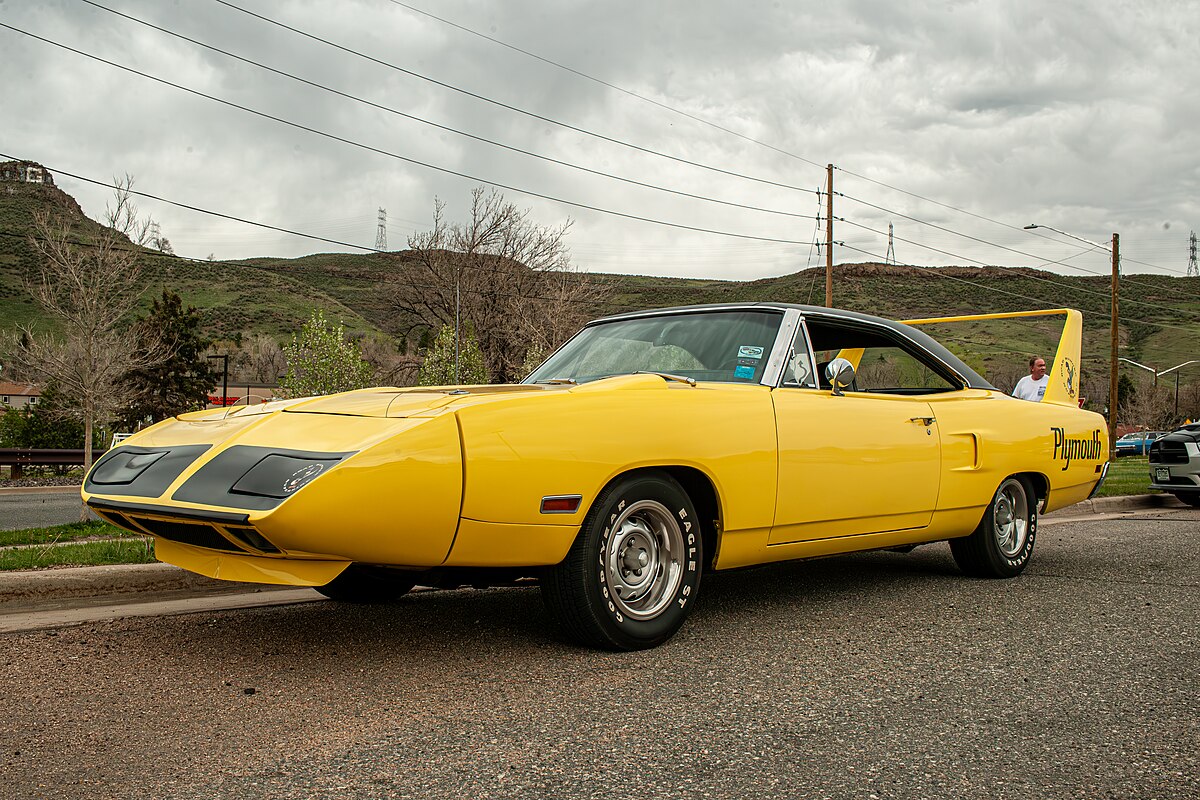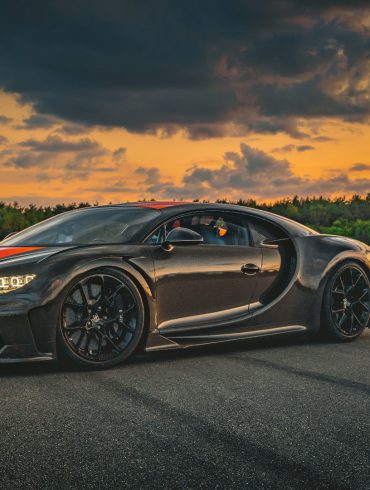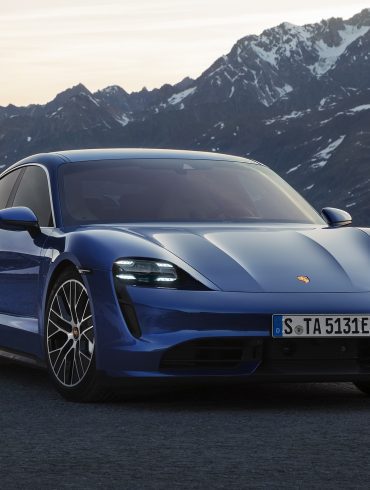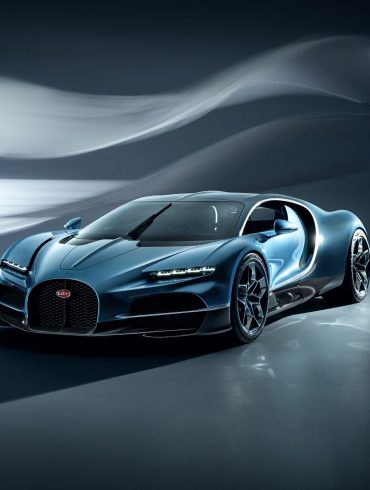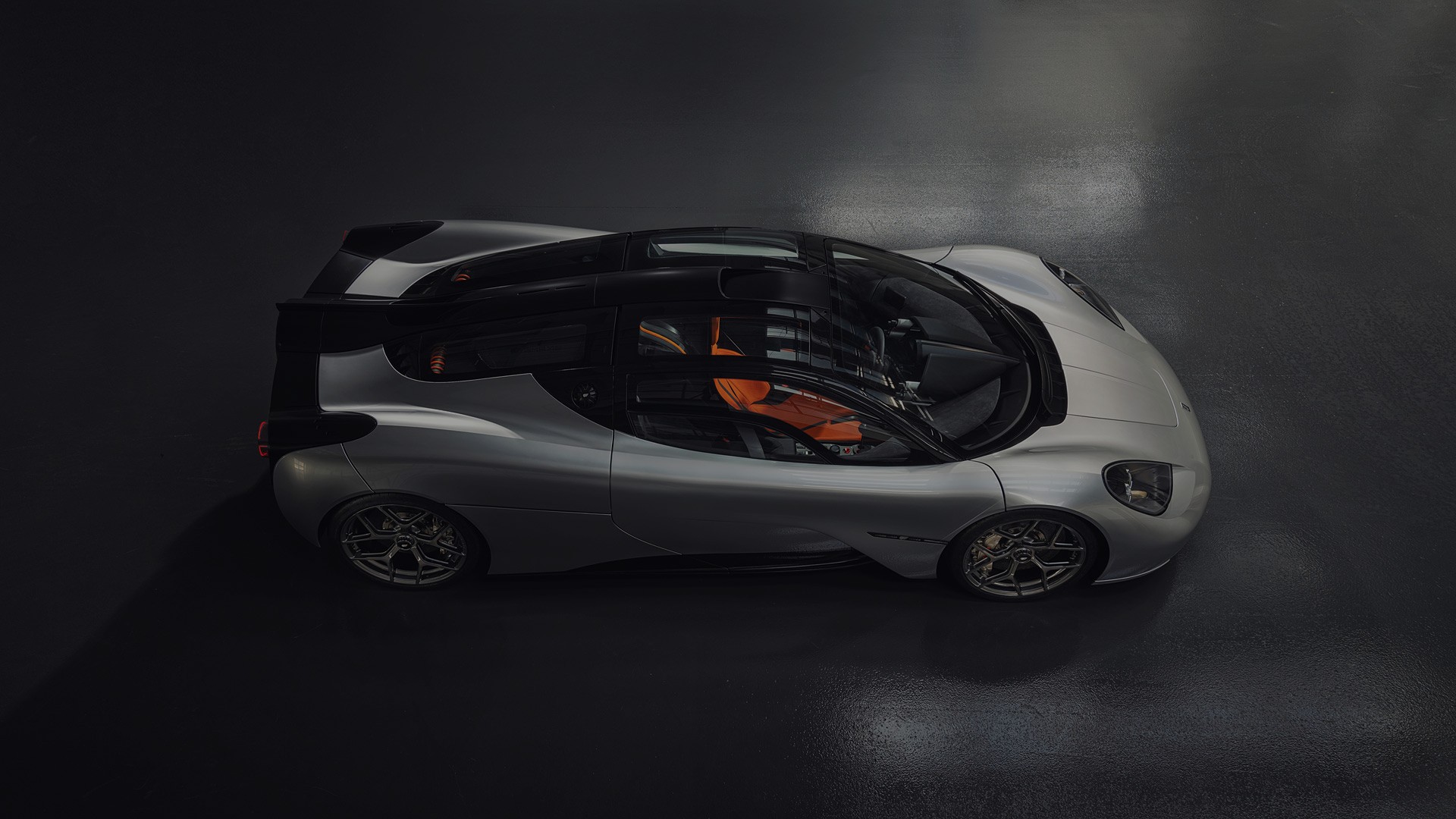1970s 0-60 & Quarter Mile Times
1970s Automotive Acceleration & Performance Data
Welcome to the ultimate guide to 0-60 mph and quarter mile times for 1970s cars! This page is your go-to resource for the most accurate, comprehensive, and easily accessible performance statistics of classic vehicles from the 1970s. Whether you're a vintage car enthusiast, a historian, or simply fascinated by automotive history, our meticulously curated database offers unparalleled insights into the acceleration and speed of these timeless machines. Explore the remarkable performance of 1970s cars.
1970s Acceleration (0-60 mph & Quarter Mile Times)
1970s 0-60 mph and quarter-mile acceleration times. Narrow down your search via the filters.
You are trying to load a table of an unknown type. Probably you did not activate the addon which is required to use this table type.
The Fifteen Fastest Cars of the 1970s
The Quickest Cars of the 1970s Ranked
The 1970s were a decade of significant challenges and transformations for the automotive industry. This period saw a shift in focus due to new regulations, economic pressures, and evolving consumer preferences, impacting both American and European car manufacturers.
In the United States, the early 1970s continued the muscle car trend, with brands like Chevrolet and Ford at the forefront. Chevrolet's Camaro and Corvette remained popular, with high-performance models like the Z28 and the Stingray. Ford's Mustang also continued to evolve, though it faced increasing competition from other muscle cars like the Dodge Challenger and Plymouth Barracuda. However, the 1973 oil crisis drastically changed the landscape. The sudden increase in fuel prices and the introduction of stringent emissions regulations forced manufacturers to pivot towards more fuel-efficient and environmentally friendly vehicles. This led to a decline in the popularity of traditional muscle cars, which were known for their large, fuel-hungry V8 engines.
In response to these challenges, American manufacturers began focusing on smaller, more efficient engines. The era saw the introduction of more compact cars like the Ford Pinto and Chevrolet Vega. While these models aimed to meet new economic and regulatory demands, they often fell short in terms of performance and build quality compared to their predecessors. The shift in focus also led to advancements in emissions control technologies, such as catalytic converters and electronic fuel injection, which would lay the foundation for future innovations in engine efficiency and environmental compliance.
Across the Atlantic, European manufacturers faced similar pressures but responded differently. Brands like Ferrari, Aston Martin, and Jaguar continued to emphasize performance but also began integrating more advanced technologies to meet new emissions standards. Ferrari introduced models like the 308 GTB, which featured lighter materials and improved aerodynamics to maintain performance while addressing fuel efficiency concerns. Aston Martin, though facing financial difficulties, produced the V8 Vantage, which combined luxury with powerful performance, adapting to the changing market demands. Jaguar continued to innovate with the XJ series, blending performance, luxury, and advanced engineering. European manufacturers also placed a greater emphasis on turbocharging technology during this decade. Porsche, for example, introduced the 911 Turbo in 1975, which became an icon for its combination of performance and efficiency. This period also saw advancements in safety and handling, with European brands leading the way in adopting features like anti-lock brakes and improved suspension systems, which would become standard in the years to come.
Overall, the 1970s were a decade of adaptation and transition for the automotive industry. American brands like Chevrolet and Ford had to navigate the decline of the muscle car era and the rise of fuel-efficient models, while European brands like Ferrari, Aston Martin, and Jaguar focused on integrating new technologies to maintain their performance edge. Despite the challenges, the innovations and regulatory changes of the 1970s set the stage for the more advanced and diversified automotive landscape that would emerge in the following decades.
1. 1971 Lamborghini Miura SVJ
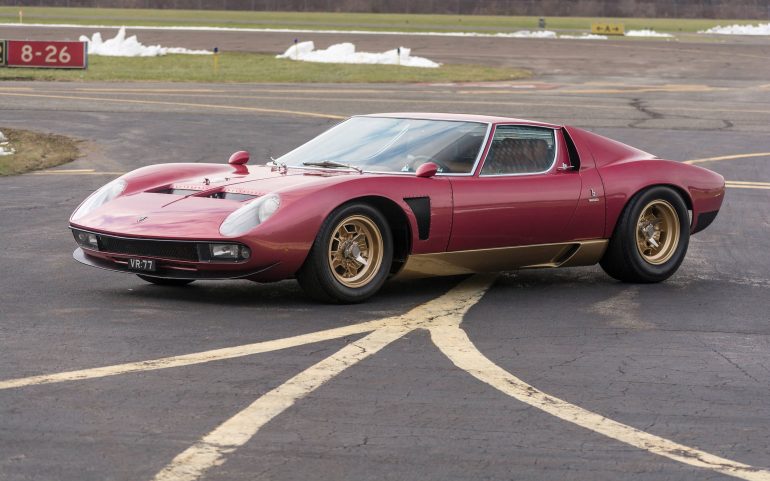
0 - 60: 3.6 seconds / Quarter Mile: N/A seconds
Summary
The 1971 Lamborghini Miura SVJ is a legendary and elusive supercar, an icon of automotive history that embodies the raw power and uncompromising performance of its era. While never officially produced by Lamborghini, a select few Miura SV models were upgraded to SVJ specifications, making them even more exclusive and sought-after by collectors and enthusiasts.
The SVJ, which stands for "Super Veloce Jota," was a track-focused iteration of the already impressive Miura SV. It featured a number of performance enhancements, including a more powerful engine, a revised suspension, and improved aerodynamics. The exact specifications of each SVJ varied, as they were individually modified to meet the specific requests of their owners. However, the SVJ's 3.9-liter V12 engine was reported to produce between 380 and 440 horsepower, depending on the state of tune. This power, combined with the car's lightweight construction, enabled it to achieve a 0 to 60 mph time of under 4 seconds and a top speed of around 180 mph.
The SVJ's performance wasn't just about straight-line speed. It also boasted exceptional handling and agility, thanks to its revised suspension and aerodynamic enhancements. The car's distinctive design, with its wide stance, flared fenders, and aggressive spoilers, not only made it visually striking but also improved its high-speed stability. The SVJ's rarity and mystique, combined with its impressive performance, have solidified its place as a holy grail among Lamborghini enthusiasts.
2. 1970 Plymouth Road Runner
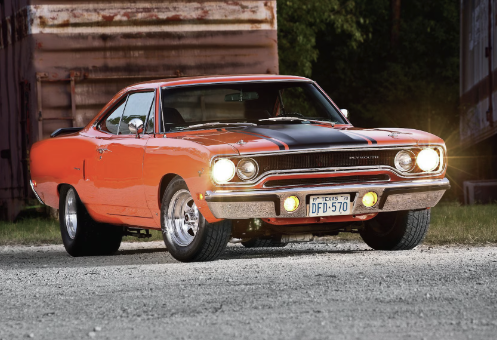
0 - 60: 4.9 seconds / Quarter Mile: 13.5 seconds
Summary
The 1970 Plymouth Road Runner was a quintessential muscle car, embodying the raw power and performance that defined the era. It was a stripped-down, no-frills machine designed for speed and affordability, making it a popular choice among enthusiasts who craved exhilarating acceleration and quarter-mile dominance.
Under the hood, the 1970 Road Runner offered a range of powerful V8 engines, catering to different performance desires. The base engine was a 383 cubic inch V8, but buyers could opt for the more potent 440 Six Barrel or the legendary 426 Hemi. The 440 Six Barrel, with its three two-barrel carburetors, produced 390 horsepower and 490 lb-ft of torque, propelling the Road Runner from 0 to 60 mph in around 6.0 seconds. Meanwhile, the mighty Hemi, with its 425 horsepower and 490 lb-ft of torque, could achieve the same sprint in just 4.9 seconds.
But the Road Runner wasn't just about straight-line speed. It also offered surprisingly good handling for a muscle car of its time. Its heavy-duty suspension, wide tires, and optional power brakes provided a level of control and stability that was uncommon for cars with such immense power. Its distinctive "beep-beep" horn, inspired by the Looney Tunes character, added a playful touch to its otherwise aggressive persona. The 1970 Plymouth Road Runner remains an iconic muscle car, celebrated for its raw power, legendary engines, and no-frills attitude. It represents a golden era in American automotive history, when performance ruled the streets and the drag strip.
3. 1970 Ferrari 365 GTB/4 Daytona
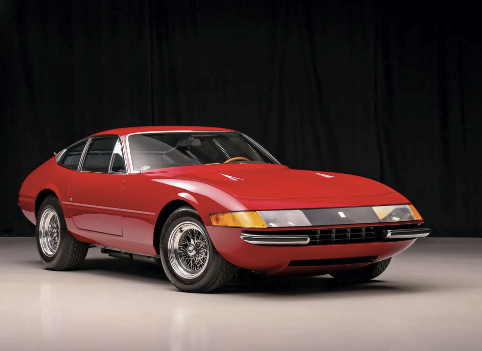
0 - 60: 5.3 seconds / Quarter Mile: 13.5 seconds
Summary
The 1970 Ferrari 365 GTB/4 Daytona, often simply referred to as the "Daytona," is a legendary grand touring car that solidified Ferrari's reputation for building high-performance machines with breathtaking beauty. Its sleek, aerodynamic design, penned by Pininfarina, is a timeless classic that still turns heads today.
Under its long, sculpted hood, the Daytona housed a 4.4-liter Colombo V12 engine, a masterpiece of engineering that produced 352 horsepower at 7,500 rpm and 318 lb-ft of torque at 5,500 rpm. This potent powerplant, paired with a five-speed manual transaxle gearbox, propelled the Daytona to a top speed of 174 mph (280 km/h), making it the fastest production car in the world at the time of its release. It could also sprint from 0 to 60 mph in just 5.3 seconds, a remarkable feat for its era.
The Daytona's performance wasn't just about straight-line speed. Its independent suspension and disc brakes on all four wheels provided excellent handling and braking capabilities, allowing it to tackle corners with confidence and precision. The car's balanced chassis and responsive steering further enhanced its driving dynamics, making it a joy to drive on both the road and the track. The Daytona's success in various motorsport events, including the 24 Hours of Daytona and the Tour de France Automobile, solidified its reputation as a performance icon.
4. 1970 Ford Mustang Boss 429
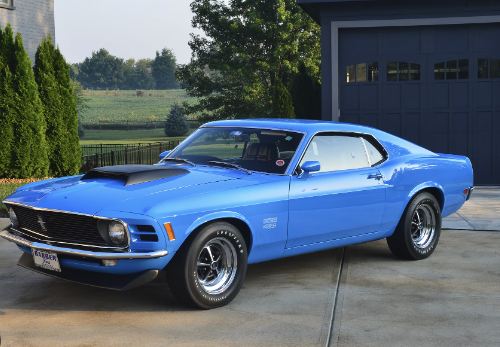
0 - 60: 5.3 seconds / Quarter Mile: 12.6 seconds
Summary
The 1970 Ford Mustang Boss 429 is a legendary muscle car that holds a special place in automotive history. Designed to dominate NASCAR, this homologation special was equipped with a massive 429 cubic inch (7.0-liter) semi-hemispherical V8 engine, affectionately nicknamed the "Boss 9." While officially rated at a modest 375 horsepower and 450 lb-ft of torque, the engine was notoriously underrated and was said to produce well over 500 horsepower in reality.
This immense power, coupled with a four-speed manual transmission and a Traction-Lok differential, made the Boss 429 an absolute rocket on the drag strip. With a 0 to 60 mph time of around 5.3 seconds and a quarter-mile time in the mid 12-second range, one of the quickest cars of its era. However, its performance was somewhat hampered by its heavy weight and the limitations of its street-legal configuration.
Beyond its straight-line speed, the Boss 429 also boasted a competition suspension, power steering, and power front disc brakes, which improved its handling and stopping power compared to the standard Mustang. However, it wasn't as nimble as some of its smaller rivals, and its size and weight were evident on twisty roads.
Despite its limitations, the 1970 Ford Mustang Boss 429 remains a highly sought-after collector's car, cherished by enthusiasts for its legendary engine, aggressive styling, and rarity. It represents a golden era in American automotive history, when muscle cars ruled the streets and the drag strip.
5. 1970 Chevrolet Chevelle SS 454
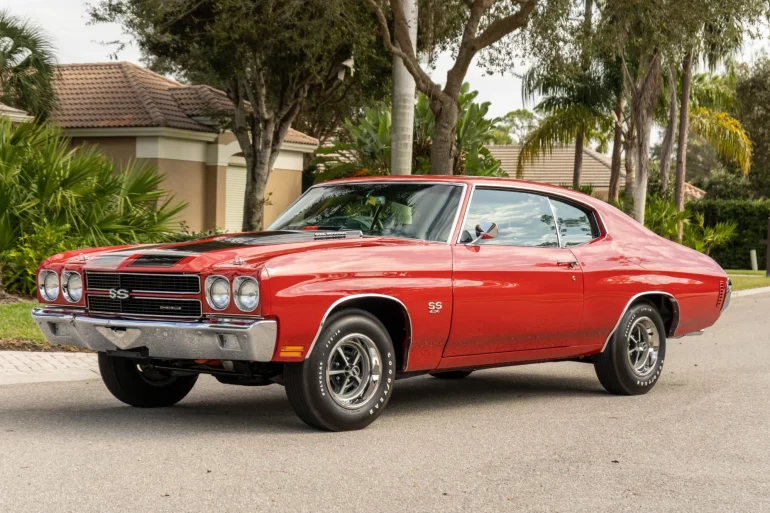
0 - 60: 5.3 seconds / Quarter Mile: 13.6 seconds
Summary
The 1970 Chevrolet Chevelle SS 454 is a legendary muscle car that has earned its place in automotive history as one of the most iconic and powerful vehicles of its era. Its aggressive styling, with its bulging hood, wide stance, and SS badging, hinted at the monstrous power that lurked beneath.
The heart of the Chevelle SS 454 was its namesake engine, a massive 454 cubic inch (7.4-liter) V8 that was available in two distinct configurations. The LS5 version produced a healthy 360 horsepower and 500 lb-ft of torque, providing ample power for exhilarating acceleration. However, the true beast was the LS6 version, which boasted a staggering 450 horsepower and 500 lb-ft of torque. This engine, paired with either a Muncie four-speed manual or Turbo Hydra-Matic automatic transmission, could propel the Chevelle SS 454 from 0 to 60 mph in 5.3 seconds and through the quarter-mile in under 14 seconds.
The Chevelle SS 454 wasn't just about brute force, though. Its performance package also included a heavy-duty suspension, power brakes, and wider tires, ensuring it could handle its immense power and provide a surprisingly balanced driving experience. While not as nimble as some smaller sports cars, the Chevelle SS 454 was surprisingly agile for its size and could hold its own on winding roads. Its roaring exhaust note, a symphony of V8 power, added to the thrill of driving this legendary muscle car.
6. 1971 Pontiac Firebird Trans Am 455 H.O.

0 - 60: 5.4 seconds / Quarter Mile: 13.8 seconds
Summary
The 1971 Pontiac Firebird Trans Am 455 H.O. (High Output) was a true American muscle car that roared through an era of tightening emissions regulations. While its power figures may seem modest compared to its predecessors, it still packed a punch and offered a thrilling driving experience.
Under the hood, the Trans Am 455 H.O. featured a robust 455 cubic inch (7.5-liter) V8 engine, equipped with a single four-barrel carburetor. This powerplant, officially rated at 325 horsepower, delivered 455 lb-ft of torque at a low 2,800 rpm. This ample torque, combined with either a three-speed automatic or a Muncie four-speed manual transmission, provided strong acceleration and a satisfying surge of power. While official 0-60 mph times vary, the Trans Am 455 H.O. could reportedly achieve the sprint in 5.4 seconds.
The Trans Am 455 H.O.'s performance wasn't just about straight-line speed. It also benefited from upgraded suspension components, a limited-slip differential, and power disc brakes, enhancing its handling and responsiveness. While its large size and weight limited its agility compared to smaller sports cars, the Trans Am could still hold its own on winding roads and deliver a fun and engaging driving experience. Its iconic styling, with its shaker hood, rear spoiler, and bold graphics, further solidified its appeal as a true American muscle car.
7. 1978 Ferrari 512 Berlinetta Boxer
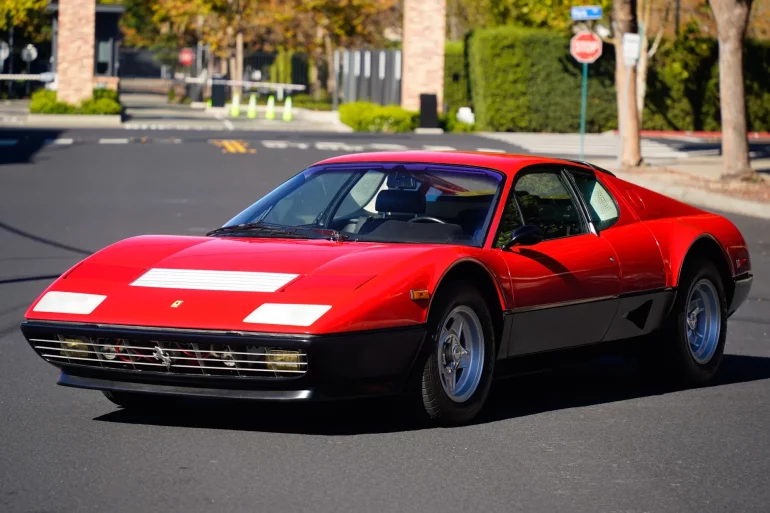
0 - 60: 5.4 seconds / Quarter Mile: 13.7 seconds
Summary
The 1978 Ferrari 512 Berlinetta Boxer (BB) was a mid-engined marvel that embodied the Italian marque's passion for performance and elegance. As the successor to the 365 GT4 BB, it featured a larger, more powerful engine and subtle design refinements that further enhanced its appeal.
Under its sleek, Pininfarina-designed bodywork, the 512 BB housed a 5.0-liter flat-12 engine, a horizontally opposed powerhouse that produced 360 horsepower (later revised to 340 horsepower). This engine, paired with a 5-speed manual transmission, propelled the car from 0 to 60 mph in around 5.4 seconds and on to a top speed of over 180 mph (though Ferrari claimed a slightly optimistic 188 mph).
The 512 BB's performance wasn't just about straight-line speed. It also boasted sharp handling and precise steering, thanks to its mid-engine layout and well-tuned suspension. The car's wide track and sticky tires provided ample grip, allowing it to confidently tackle corners. However, some drivers found its handling to be a bit twitchy at the limit, requiring a skilled hand to fully exploit its potential.
The 512 BB was not just a performance machine; it was also a luxurious grand tourer. Its cabin was well-appointed with leather upholstery, power windows, and air conditioning, providing a comfortable and refined environment for both driver and passenger. The 512 BB remains a highly sought-after classic Ferrari, cherished by enthusiasts for its stunning design, powerful engine, and exhilarating driving experience. It represents a significant chapter in Ferrari's history and a testament to the brand's dedication to performance and luxury.
8. 1978 Porsche 911 Turbo 3.3 Coupe (930)
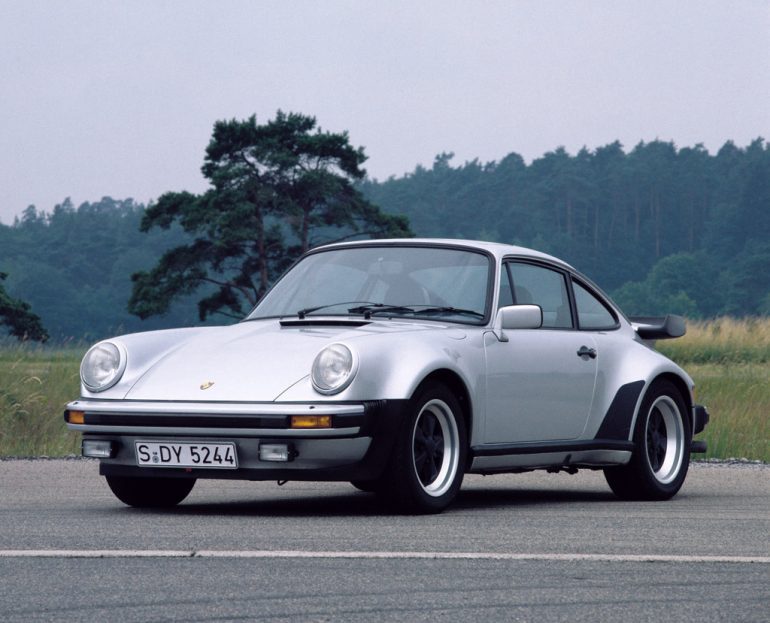
0 - 60: 5.4 seconds / Quarter Mile: 14.0 seconds
Summary
The 1978 Porsche 911 Turbo 3.3 Coupe (930) was a game-changer in the sports car world, introducing a level of performance previously unheard of in a production car. Its iconic "whale tail" spoiler and wide body stance not only made it visually striking but also served a functional purpose, improving aerodynamics and downforce.
Underneath its distinctive bodywork, the 930 Turbo 3.3 housed a turbocharged 3.3-liter flat-six engine, a technological marvel that produced 300 horsepower and 304 lb-ft of torque. This power, combined with a four-speed manual transmission, propelled the car from 0 to 60 mph in around 5.4 seconds, an impressive feat for its time. Its top speed of 160 mph further cemented its status as a performance icon.
The 930's performance wasn't just about straight-line speed. It also boasted a sport-tuned suspension, wider tires, and powerful brakes that gave it impressive handling and stopping power. However, its rear-engine, rear-wheel-drive layout and turbocharged power delivery could make it a handful to drive, especially in inexperienced hands. The 930's raw power and demanding nature earned it the nickname "Widowmaker," but for skilled drivers, it offered an exhilarating and rewarding driving experience.
Despite its challenges, the 1978 Porsche 911 Turbo 3.3 Coupe (930) remains a legend in the automotive world. Its iconic design, groundbreaking performance, and raw driving experience have made it a sought-after collector's item and a symbol of Porsche's commitment to pushing the boundaries of performance engineering.
9. Porsche 911 Carrera RS 2.7 Lightweight
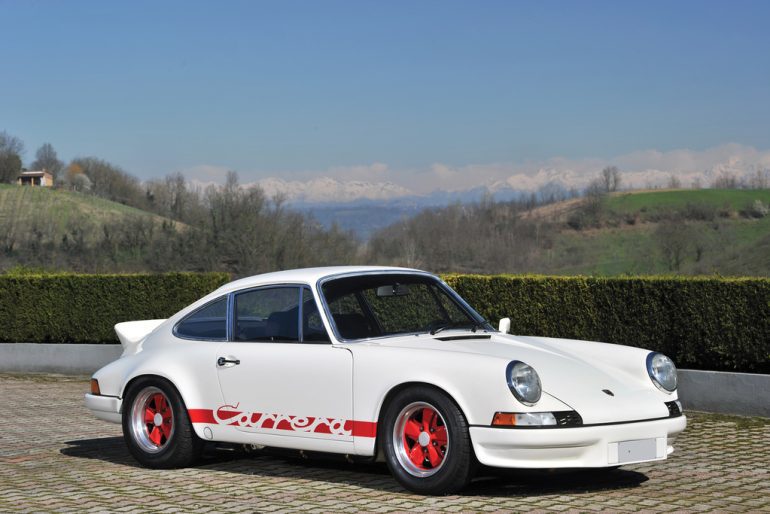
0 - 60: 5.5 seconds / Quarter Mile: N/A seconds
Summary
The 1973 Porsche 911 Carrera RS 2.7 Lightweight was a homologation special built by Porsche to meet racing regulations. It was a stripped-down, track-focused version of the already potent 911 Carrera RS, and is considered one of the most desirable Porsches ever made. Its iconic "ducktail" spoiler and wider bodywork not only reduced lift but also added to its aggressive appearance.
While the standard Carrera RS had a 2.7-liter flat-six engine with 210 horsepower and 188 lb-ft of torque, the Lightweight version shed significant weight by using thinner steel for the body panels, thinner glass for the windows, and fiberglass bumpers. This resulted in a curb weight of just 975 kg (2,150 lb), making it incredibly agile and responsive. The Lightweight could sprint from 0 to 60 mph in a mere 5.5 seconds and reach a top speed of 152 mph.
But the 911 Carrera RS 2.7 Lightweight's performance wasn't just about straight-line speed. Its lightweight construction, combined with a revised suspension setup and wider tires, significantly improved its handling and agility. The car felt incredibly balanced and communicative, allowing drivers to push it to its limits with confidence. The 911 Carrera RS 2.7 Lightweight's combination of power, handling, and lightweight design made it a formidable force on the track and a sought-after collector's car. Its legacy continues to inspire Porsche's performance philosophy today, emphasizing the importance of agility, responsiveness, and driver engagement in its sports cars.
10. 1976 Ford Gran Torino
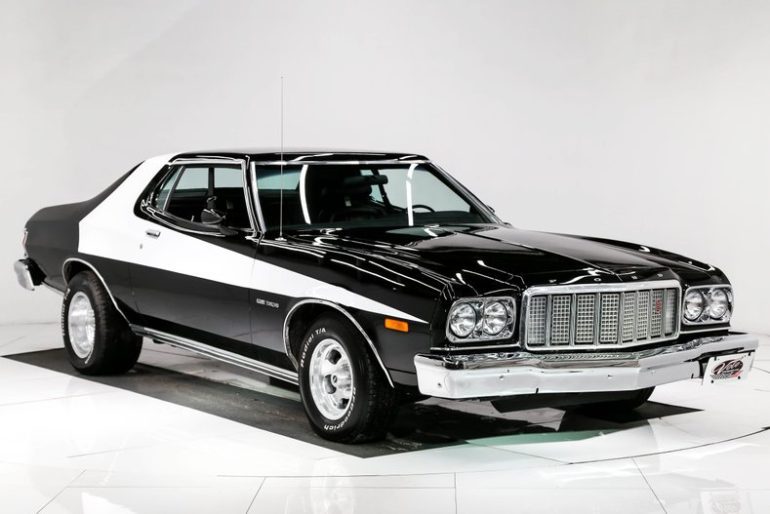
0 - 60: 5.5 seconds / Quarter Mile: 13.9 seconds
Summary
The 1976 Ford Gran Torino, while not renowned for blistering speed, holds a special place in automotive history for its iconic status in popular culture and its representation of the changing landscape of American muscle cars. This was a time of transition, with stricter emissions regulations and a shift towards fuel efficiency, impacting the performance of many classic muscle cars.
Under the hood, the 1976 Gran Torino offered a range of engine options, including a 351 cubic inch (5.8-liter) V8 as its most powerful choice. It resulted in a 0 to 60 mph time of around 5.5 seconds.
While not a performance powerhouse, the Gran Torino still offered a comfortable ride and decent handling for a large car. Its suspension was tuned for cruising comfort, and its wide stance provided stability on the highway. The car's spacious interior, plush seating, and available luxury features like power windows and air conditioning, made it a popular choice for those seeking a comfortable and stylish daily driver.
The 1976 Ford Gran Torino's legacy extends beyond its performance figures. Its iconic "Starsky and Hutch" livery and starring role in the popular TV show of the same name cemented its place in popular culture. While it may not have been the fastest car on the road, it captured the spirit of a changing era and remains a beloved classic among car enthusiasts today.
11. 1970 Plymouth AAR Cuda
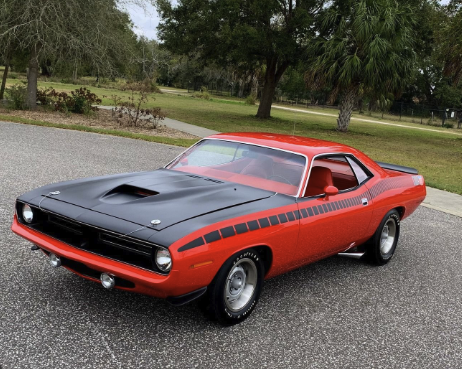
0 - 60: 5.6 seconds / Quarter Mile: 13.9 seconds
Summary
The 1970 Plymouth AAR 'Cuda, a homologation special built for the Trans Am racing series, was a road-legal version of the race car driven by Dan Gurney's All American Racers (AAR) team. Its unique styling and performance upgrades set it apart from the standard 'Cuda, making it a sought-after muscle car for enthusiasts and collectors alike.
Under its hood, the AAR 'Cuda featured a 340 cubic inch V8 engine equipped with three two-barrel carburetors, known as the "Six Pack" setup. This configuration allowed for improved airflow and increased power output compared to the standard 340 engine. With 290 horsepower and 345 lb-ft of torque at its disposal, the AAR 'Cuda could sprint from 0 to 60 mph in around 5.6 seconds and complete the quarter-mile in 13.9 seconds.
Beyond its potent engine, the AAR 'Cuda also received several performance-oriented upgrades. It featured a heavy-duty suspension with a thicker front sway bar, staggered rear shocks, and upgraded leaf springs. The car also came with wider tires, a 3.55:1 rear axle ratio, and front disc brakes, further enhancing its handling and braking capabilities. Visually, the AAR 'Cuda stood out with its unique fiberglass hood with a functional air scoop, side-exit exhaust tips, and bold AAR graphics. Inside, the car's interior was spartan but functional, with high-back bucket seats and a pistol-grip shifter.
The 1970 Plymouth AAR 'Cuda remains a legendary muscle car, celebrated for its racing heritage, unique styling, and impressive performance. While not as powerful as its Hemi-powered siblings, it offered a more balanced and agile driving experience, making it a formidable contender on both the street and the track.
12. 1974 Lamborghini Urraco P300
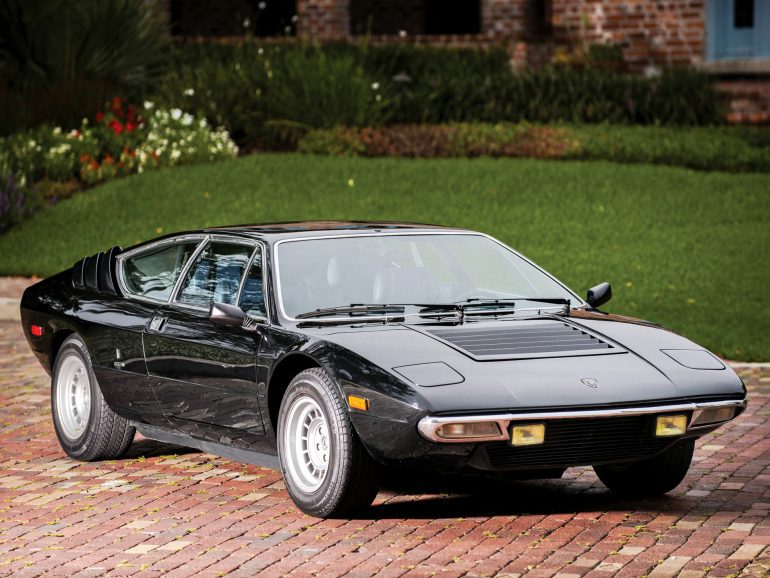
0 - 60: 5.6 seconds / Quarter Mile: N/A seconds
Summary
The 1974 Lamborghini Urraco P300 was a significant model in Lamborghini's history, as it represented the brand's foray into the more affordable sports car market. Designed to compete with the likes of the Ferrari Dino and Porsche 911, the Urraco P300 aimed to offer a taste of Lamborghini's performance and style at a more accessible price point.
Under the hood, the Urraco P300 housed a 2,996cc V8 engine, the largest of the Urraco lineup, producing an impressive 247 horsepower at 7,500 rpm and 195 lb-ft of torque at 3,500 rpm. This power, combined with its lightweight design, allowed the P300 to achieve a 0 to 60 mph time of 5.6 seconds and reach a top speed of 155 mph. These figures were quite impressive for the time and made the P300 a competitive player in the sports car market.
The P300's performance wasn't just about raw power. Its mid-engine layout and independent suspension provided agile handling and responsive steering, making it a joy to drive on winding roads. The car's distinctive wedge-shaped design, penned by Marcello Gandini at Bertone, not only looked stunning but also contributed to its aerodynamic efficiency. Despite its smaller size compared to other Lamborghinis of the era, the P300 didn't compromise on style or performance, offering a compelling package for those seeking a taste of the Lamborghini experience.
13. 1970 Plymouth Duster
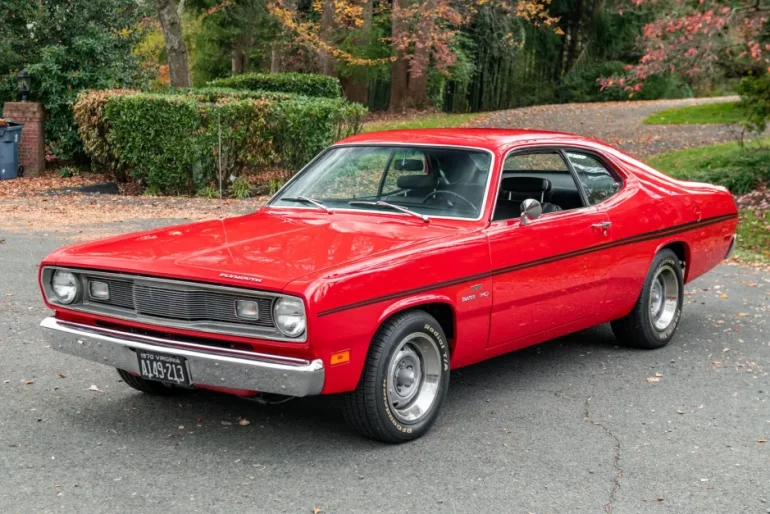
0 - 60: 5.7 seconds / Quarter Mile: 14.1 seconds
Summary
The 1970 Plymouth Duster, a compact and sporty car, was a welcome addition to the muscle car era, offering a more affordable and nimble alternative to larger, heavier models. While not as powerful as its big-block brethren, the Duster still packed a punch and delivered a fun-to-drive experience.
The Duster was available with several engine options, ranging from the economical Slant Six to the potent 340 cubic inch V8. The 340 V8, with its 275 horsepower and 340 lb-ft of torque, was the performance highlight of the lineup. It could propel the Duster from 0 to 60 mph in around 5.7 seconds and through the quarter-mile in under 14.1 seconds, impressive figures for a compact car of its time.
The Duster's performance wasn't just about straight-line speed. Its lightweight design, compact dimensions, and nimble handling made it a joy to drive on winding roads. The 340 model came with a heavy-duty suspension, wider tires, and front disc brakes, enhancing its agility and stopping power. It was a car that could hold its own against larger muscle cars in terms of handling and responsiveness.
The 1970 Plymouth Duster, especially with the 340 V8, offered an exciting and accessible entry point into the world of muscle cars. Its combination of performance, affordability, and sporty styling made it a popular choice among enthusiasts and everyday drivers alike. It remains a sought-after classic car today, appreciated for its timeless design, fun-to-drive nature, and its place in the history of American muscle cars.
14. 1971 Ford Mustang
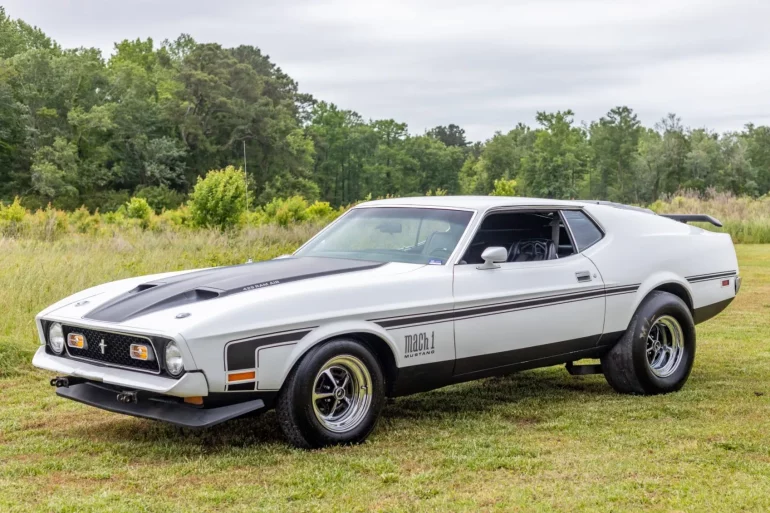
0 - 60: 5.7 seconds / Quarter Mile: 13.8 seconds
Summary
The 1971 Ford Mustang represented the pinnacle of the first generation's performance capabilities. This model year marked the final iteration before the Mustang's redesign, and it went out with a bang, offering a range of powerful engine options and aggressive styling that cemented its place in muscle car history.
The top performer in the 1971 Mustang lineup was the Boss 351, a track-oriented beast equipped with a 351 cubic inch (5.8-liter) V8 engine that produced 330 horsepower and 370 lb-ft of torque. This powerful engine, combined with a close-ratio four-speed manual transmission, could propel the Boss 351 from 0 to 60 mph in 5.7 seconds and through the quarter-mile in 13.8 seconds. Its performance figures rivaled those of some European sports cars of the era, making it a true force to be reckoned with on the street and strip.
While the Boss 351 was the undisputed king of performance, other engine options were available in the 1971 Mustang lineup, catering to various budgets and preferences. The Mach 1, for example, offered a range of V8 engines, including a 302 cubic inch (4.9-liter) V8 with up to 240 horsepower, while the base model Mustangs came with a choice of inline-six or V8 engines.
Beyond its impressive powertrain options, the 1971 Mustang also featured revised styling, with a more aggressive front end, a larger grille, and new taillights. The interior was also updated, with improved materials and a more comfortable and ergonomic design. Despite the impending redesign, the 1971 Mustang remains a highly sought-after classic car, cherished by enthusiasts for its raw power, iconic styling, and its place in the history of American muscle cars.
15. 1971 Lamborghini Miura P400 SV

0 - 60: 5.7 seconds / Quarter Mile: 14.3 seconds
Summary
The 1971 Lamborghini Miura P400 SV, often hailed as the ultimate Miura, is an automotive icon that represents the pinnacle of Lamborghini's early design and engineering prowess. This final iteration of the groundbreaking Miura model boasted several enhancements that elevated its performance and cemented its status as a legendary supercar.
Under its breathtakingly beautiful bodywork, designed by Marcello Gandini at Bertone, the Miura SV housed a transversely mounted 3.9-liter V12 engine. This naturally aspirated powerhouse produced 385 horsepower at 7850 rpm and 295 lb-ft of torque at 5750 rpm, a significant increase over the standard Miura models. Paired with a five-speed manual transmission, the SV could rocket from 0 to 60 mph in a blistering 5.7 seconds and reach a top speed of 180 mph.
But the Miura SV wasn't just about raw power. Its revised suspension geometry, wider rear track, and larger tires provided improved handling and stability, making it a more planted and predictable car to drive than its predecessors. The addition of ventilated disc brakes on all four corners also enhanced its stopping power, ensuring it could reign in its prodigious performance. The SV's interior, while still luxurious, was more driver-focused than earlier Miura models, with improved ergonomics and more supportive seats.
The 1971 Lamborghini Miura P400 SV is a masterpiece of automotive engineering and design, a car that continues to captivate enthusiasts and collectors alike. Its stunning beauty, exhilarating performance, and rarity make it one of the most desirable and valuable Lamborghinis ever produced.


